Sikorsky S-55/H-19 - History and technical description
Some historical notes
In the Sikorsky's annals the 7th of November 1949 is very important. In fact that day the Sikorsky S-55 (military designation H-19) made its first flight. Nobody yet knew that this helicopter would have a great commercial success. In that year the American company, founded by the famous rotary-wing pioneer Igor I. Sikorsky, also celebrated the tenth anniversary of the VS-300's first flight, the first successful helicopter with a main rotor and a single vertical tail rotor for antitorque.
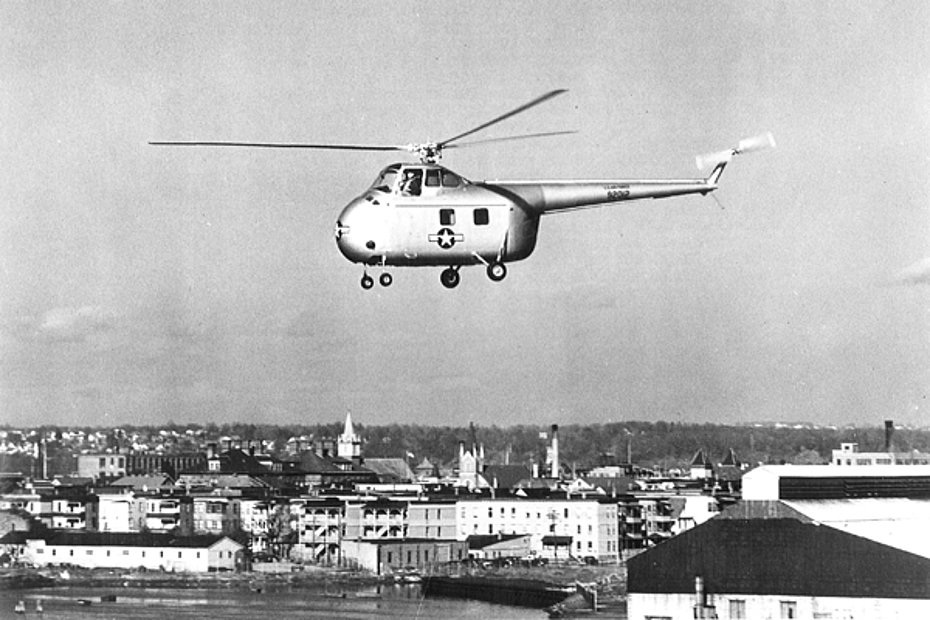
In 1946, in an effort to obtain the best ship-based helicopter for spotting, rescue, and utility missions on board battleships and cruisers, the Navy contracted with Sikorsky and Piasecki for two helicopters from each company.
Sikorsky developed the XHJS-1 (also known as the S-53) a follow-on version of the HO3S-1, a naval version of the S-51.
Compared to the latter the XHJS-1 had a more powerful 391/525 kW/shp Continental R-975-34 engine and could carry up to five occupants. To prevent accidents to shipboard personnel and to the blades striking a rolling deck when the helicopter was attempting a deck landing in heavy seas, the helicopter had a shock-mounted tail pylon which gave full head clearance under the tail rotor blades.
The landing gear was specially designed and stressed to give it the added sturdiness needed for the moment of impact with a ship’s deck in heavy seas.
The XHJS-1 had a hatch in the floor, an innovation in helicopter design, which permitted the installation of an aerial camera or the operation of an internal hoist for cargo loading or air-sea rescue pick-up.
The first of the two prototypes made its first flight on the 22nd of September 1947. The test flights continued in the following months.
In 1948, after a comparative evalutation, the Navy selected the Piasecki XHJP-1 (later redesignated by the Navy as the HUP-1).
One major reason for the selection of the HUP-1 was that the XHJS-1 required a ballast change in order to accommodate a change in the loading. This great limitation led Sikorsky to immediately design another helicopter to adjust the problem, but as previously said it was too late.
In 1949 the Helicopter Divisional Office of the US Air Force Army announced that it was interested in receiving proposals for a new helicopter.
The Sikorsky didn't waste any time and prepared a mock-up to present its new project which was a follow-on version of the XHJS-1.
The project was accepted and on the 1st of May 1949 Sikorsky’s technical department was given the task to build the first of five prototypes (serial number 49-2012/2016) designated YH-19 by the Army.
In an outstanding aircraft design and fabrication performance, Sikorsky's technicians completed the helicopter in six months, and on the 7th of November the S-55/YH-19 made its first test flight in Bridgeport/Connecticut piloted by Dimitry D. (Jimmy) Viner (1908-1998), nephew of Igor I. Sikorsky.
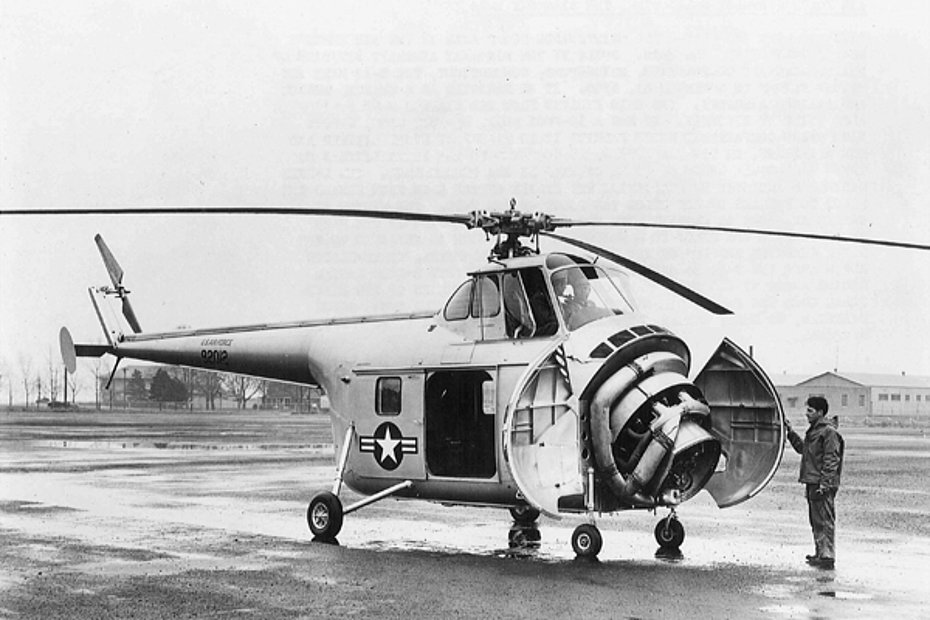
A cutting-edge solution
An outstanding feature of the S-55/YH-19 was the location of its engine in the nose of the aircraft where it is easily accessible for maintenance work from the ground. This innovative arrangement allows the placement of a large and unobstructed room-like passenger/cargo cabin directly under the main rotor.
This location at the center of gravity allows payload to be added or removed without affecting the aircraft’s balance.
The first prototype differed from subsequent production models in having a blunt end to the fuselage beneath the tail boom. This was in fact later filled in by a triangular fin. Another feature of the YH-19 was a horizontal half tailplane on the starboard side with an endplate vertical fin. On the production models it was replaced with two small fins forming an inverted V ahead of tail rotor.
Several other modifications more or less visible were introduced on the following variants.
After the evaluation tests the US Air Force purchased a first batch of the series military known as the H-19A, powered by a 447/600 kW/shp Pratt & Whitney Wasp R-1340-57 radial engine.
The general aspect of the S-55/H-19 was maintained, even if the following versions each presented slight differences such as for example a more powerful 596/800 kW/shp Wright Cyclone R-1300-3, an inclined tail boom, a different tail rotor pylon, a new horizontal stabilizer.
With the outbreak of the Korean war in 1950, the US armed forces ordered the H-19 in large quantities. The helicopter was nicknamed "Chickasaw" like the native American people originally from the Southeastern region of the United States.
During the Korean conflict the H-19 (designated HO4S by us Navy and HRS-1, 2, 3 by the US Marine Corps) was mainly used for the transportation of troops, ammunitions and armaments, aerial supply, medical evacuation, liaison, observation, assault, downed aircrew rescue as well as the rescue of military hardware.
Along with Piasecki HRP series the H-19 holds the distinction of being the first true transport helicopter and, as such, played an important role in the initial formulation of Army doctrine regarding air mobility and the battlefield employment of troop-carrying helicopters.
As already told, the helicopter was a commercial success. Based on the gathered data, Sikorsky alone produced 1,281 S-55/H-19. Most of them (789) were H-19B.
In 1950 the S-55 was licensed for production to Westland Aircraft which then also developed its own versions known as the Whirlwind.
In 1952 the French company SNCASE was also licensed to produce the S-55/H-19. Later, in 1958, the S-55/H-19 was licensed to the Japan company Mitsubishi.
In 1953 the price of a S-55 was about $137'500 corresponding to about 700'000 Sfr.
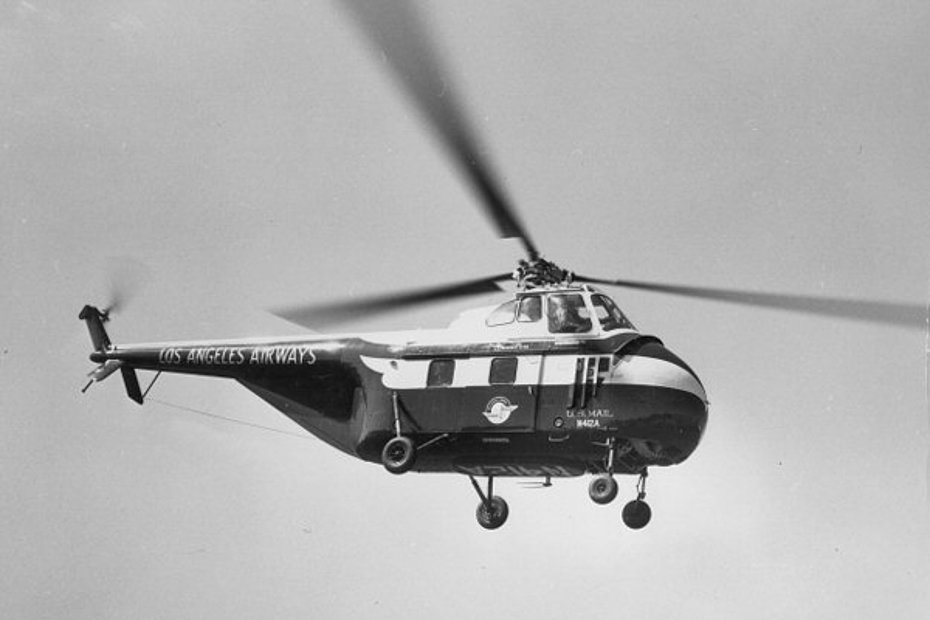
The Sikorsky S-55 helicopter in civil service
The military feats of the H-19 in Korea soon captured civil operator's interest.
From 1946 on, the civil operators discovered the versatility of the rotary-wing and at the same time were looking for a helicopter with a greater payload than the two-three seater such as the Bell 47 or the Hiller UH-12.
For this reason Sikorsky undertook the test program with the objective to obtain the civil certification, an essential indispensable step for a manufacturer who intend to sell a helicopter to civil customers.
The civil certification for the commercial S-55 series was first awarded on the 25th of March 1952 (Type Certificate 1H4).
Among the first customers to use the S-55 we should mention New York Airways (NYA) which used it at the beginning for mail transportation. In July 1953 NYA started to use its S-55 fleet for the transportation of passengers too.
On the 1st of September 1953 Sabena began to use the S-55 for the world's first international/European helicopter service. The helicopters were used on short routes such as Brussels (Heliport) to Rotterdam and Maastricht in the Netherlands, Köln and Bonn in Germany.
In the '50s expanding oil industry operations were creating a need for larger helicopters. Petroleum Helicopter Inc. (PHI), one of the world's largest civil helicopter companies, purchased its first S-55 in January 1954. The experiences with this model were so positive that PHI soon ordered other units.
The H-19 remained in service with the Armed Forces until about the mid ‘60s. It was then replaced by the first generation of turbine powered helicopters such as for example the famous Bell UH-1 Huey.
The operational life of the civil S-55 was on average longer.
In the United States some aviation companies "civilized" the military H-19 series to be used by commercial operators.
Among these there was for example, the Aviation Specialties Inc. of Mesa, Arizona. The company obtained a supplemental type certificate to replace the Wright R-1300-3 reciprocating engine in its Sikorsky S-55B helicopter with an AiResearch TSE 331-3U-303N turboshaft engine.
The turbo-shaft has approximately the same horsepower rating as the Wright engine. However the modification resulted in a reduction of about 340 kg of empty weight. This change in engines also evidently involved major changes to the S-55B type design. One of this conversions was sold in Switzerland in 1971 and received the call-sign HB-XDS.
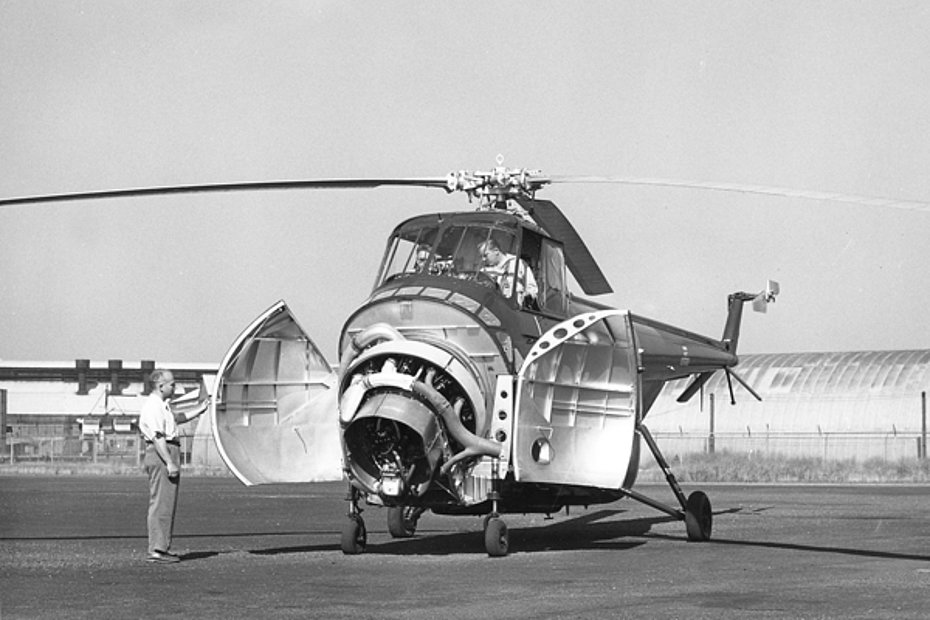
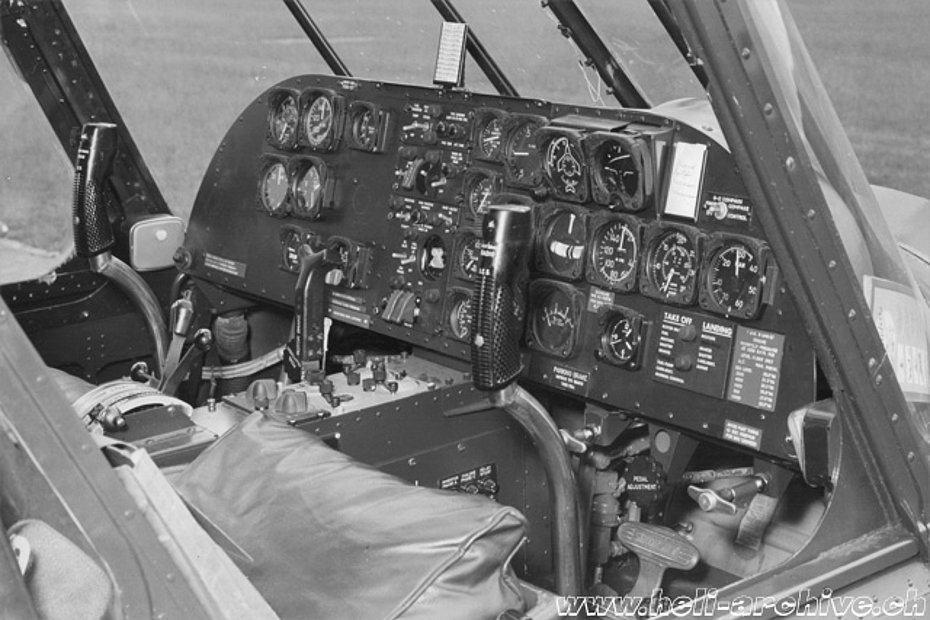
S-55 general technical description
The S-55 is a conventional helicopter using a main and anti-torque rotor, a design developped successfully from 1939 by Igor I. Sikorsky.
The fuselage is a semi-monocoque structure consisting on two main sections.
The front section incorporates the cabin, the engine, the transmission an the main rotor, while the rear section comprises the tail boom, the tail rotor and the stabilizers.
On some versions, to minimize the danger of a tail boom strike, the tail boom is angled down by 3 degrees. At customer’s request this modification was possible using a special retro-fit kit.
The forward section can readily be removed in case of necessity such for example for air transportability. The S-55 could be easily transported inside the popular Fairchild C-82 cargo aircraft.
The fuselage is a semi-monocoque structure consisting principally of alluminium and magnesium outer skin.
The main rotor, the main transmission, the tail rotor tramission and the controls are easily accessible. To inspect the main rotor on both sides of the pilot’s cabin there is a small folding platform.
The main rotor pylon consists of steel tubes from the cabin roof to the top of the main gear box. This structure thus becomes a self-contained unit, consisting of the rotor head, the main transmission with its own oil system and accessories, and the complete hydraulic servo control system.
The two-man cockpit is placed above and slightly forward of the passenger/cargo cabin with two seats placed on either side of the drive shaft. The cockpit may be entered from the outside the pilot’s window, adjacent to the large cabin door, thereby providing excellent visibility for rescue operations.
The cockpit is also accessible from the passenger’s cabin, but the passage is a bit narrow and uncomfortable. That is why usually the pilot enters from the outside using some handles and footrests. If the rotor is turning, the pilot must pay attention.
Visual in generally good on all directions. On some versions the front windshield is divided in two or four portions.
The instrument panel is located directly in front of the pilot and provides for both normal and night flying with red lighting. Easy access to the rear instrument panel is provided by removing the top fairing. Special attention has been given to the instrument grouping in accordance with numerous pilot’s requests.
The fully articulated main rotor is similar to that proved on the S-51, even if it is simpler. It has three interchangeable all-metal rotor blades. All blades are individually interchangeable and any three, including spare blades, make a flyable set, a novelty at that time. Not to be forgotten that the main rotor blades are manually foldable for easy storage.
The tail rotor assembly is similar to that which has been CAA approved for the S-51, with a two all-metal interchangeable blades see-saw arrangement.
The tail rotor is protected from ground strikes by a skid plate.
The flight controls are full dual with the pilot on the starboard side, thus permitting ready use of the left hand for radio and other controls without removing the right from the cyclic stick. The hydraulic servo control system operates on both the cyclic and the collective pitch control.
The rudder pedals are adjustable fore and aft and have individual toe brakes.
A stabilizer made of two small fins forming an inverted V is provided at the aft of tail cone to maintain optimum trim for all flight conditions and increase aircraft stability.
The helicopter has a 200 amp generator driven from an accessory drive pad on the main gear box and thus operates whenever the main rotor is turning. The 24V battery is located under the radio compartment, behind the cargo/passengers cabin.
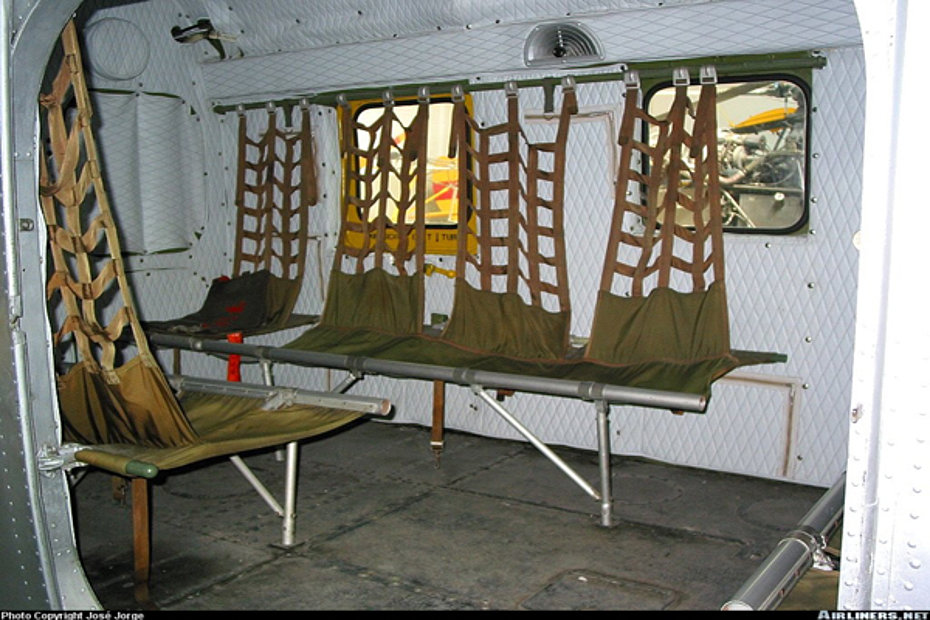
A large and unobstructed cabin
The passenger (or cargo) cabin is accessibile from the starboard side. It has a large sliding door (height 122 cm, width 116 cm). The cabin has the following dimensions: lenght 305 cm, width 158 cm, height 183 cm. Hence the internal volume is 7.64 mc.
The cabin design, which had originally two small windows (one of which was located in the sliding door), adapts itself easily to various seating and cargo arrangements. In the cabin there is space for 7 to 10 occupants.
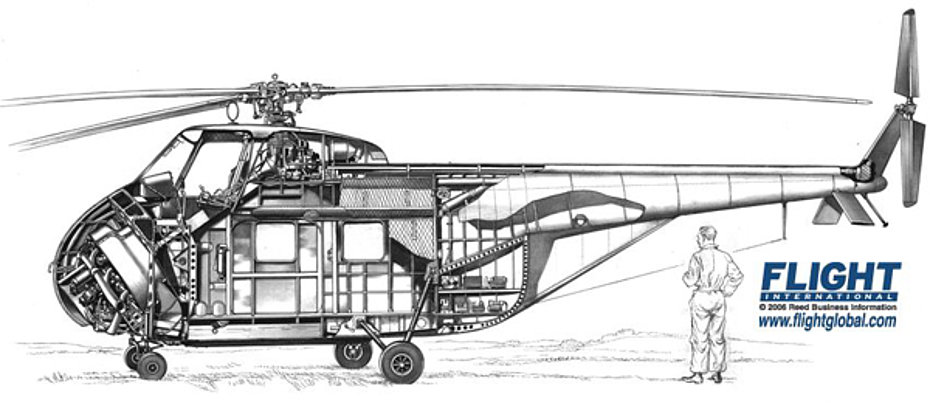
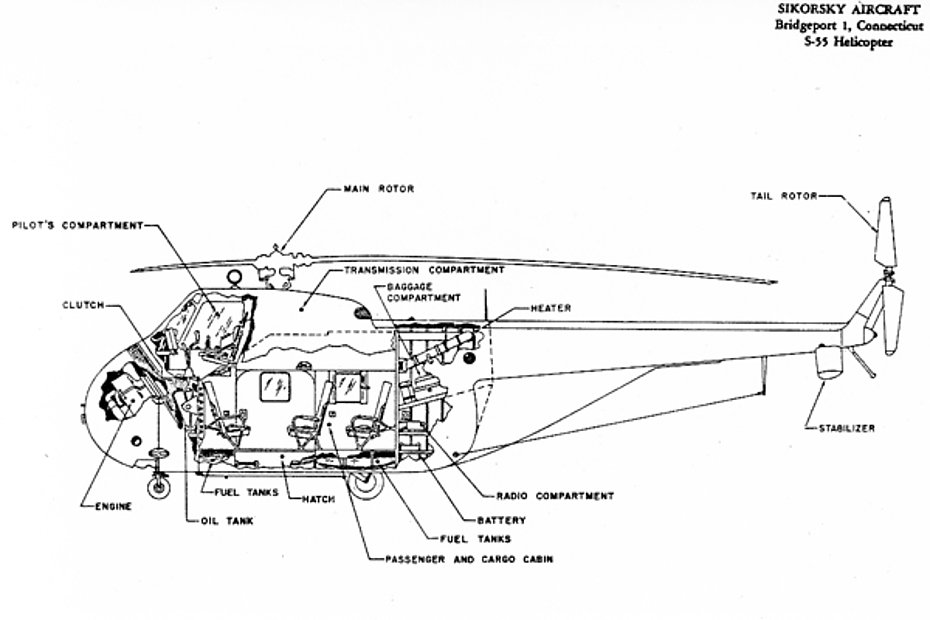
For rescue operations up to six stretchers could be carried.
The normal fuel supply (the engine uses 91/98 octane fuel) 700 litres (378 litres forward tank + 322 litres rear tank), is contained in nylon neoprene impregnated fuel cells located in the lower structure under the cabin.
Increased over-all utility is provided by a large (dimensions 120 x 50 cm) hatchway with a hinged cover in the cabin floor under the main rotor. It is ideal for photographic survey purposes, and for observations when carring loads underneath. Provisions for a cargo sling structurally capable of a 907 kg load are included in the standard equipment.
The helicopter was usually delivered with a quadricycle landing gear and each wheel has an individual hydraulic shock absorber.
The landing gear provided improved stability, not only in take-off and landing, either power-on or power-off, but also in taxiing.
The two nose wheels are full-castering and self-centering.
The tail cone supporting structure immediately aft of the cargo/passenger cabin provides space for the baggage (maximum admitted 113.4 kg) and for the radio, heating and ventilating equipment.
Many components of the S-55/H-19 were identical or similar to those used on the XHJS-1 or the S-51. For example, the intermediate and tail gear boxes were identical to those proved on the Navy XHJS-1 and the tail gear box was basically the same used on the S-51.
Powerplant
As we have seen the S-55/H-19 could be equipped with different engines.
The S-55/H-19A is powered by the nine-cylinder air-cooled radial Pratt&Whitney Wasp R-1340-57 (identical to S1H2) 22 litres cylinder capacity.
Max take-off power is 447/600 kW/shp at 2’250 rpm (1 min – pressure 36.5 in. Hg.). Maximum continuous power at sea level is 410/550 kW/shp at 2'200 rpm 34.0 in. Hg.
The 394 kg engine is equipped with a single-speed centrifugal type supercharger.
The Wasp engines were, and still are, renowned for their dependability.
Average fuel consumption under normal cruising condition is about 145 litres per hour.
Engine changes may be accomplished in two hours time without the use of a hoist or overhead lift.
At the beginning the engine needed an overhaul at 600 hours.
Performances S-55
In ISA conditions, at 3'100 kg take-off weight, the helicopter has a cruising speed of about 137 km/h, while the never exceed speed at sea level is 176 km/h.
Never exceed speed must be decreased by 8.3 km/h each 305 meters of climb.
Based on the data furnished by its manufacturer the helicopter has an absolute service ceiling of 3'950 meters.
In the same conditions the helicopter hovers in ground effect at about 2'400 meters, or 1'350 meters out of ground effect. The initial rate of climb at sea level is about 258 m/min.
Its max range with reserve is about 725 km corresponding to about 5h of flight endurance (400 km respectively 2h45' without reserve).
Limitations
The pilot must keep the main rotor RPM in the safe green arc which is comprised between 170 and 245 rpm. Normal engine speed (Pratt & Whitney) in level flight is 2'200 rpm.
The engine temperature must be kept between 120 and 260°.
Dimensions, weights and payload
The main rotor of S-55/H-19A has a diameter of 16.15 m, while its tail rotor has a diameter of 2.64 m. The fuselage has a length of 12.85 m. The height measured on the top of the rotor mast is 4.07 m.
The aircraft standard empty weight is about 2'245 kg, while its MTOW is 3'100 kg with internal load.
The S-55 usually can carry up to 7 passengers with their baggage or up to 600-650 kg of cargo in the cabin or suspended on its barycentric hook.
Optional equipment
The helicopter's versatility was further extended by the availability of a wide range of accessories such as: co-pilot's instrument, ten troop-type foldable seats, seven commercial-type seats, upholstered interior and carpeting, provision for six stretchers, cargo sling, rescue hoist (model Breeze Winch P/N BL 413 or BL 1315), anti-collision rotating light, landing lights, automatic aux fuel pump pressure switch, pneumatic float gear (pontoon type), inflatable flotation gear (doughnut type), CAA provisions for scheduled passenger operation.
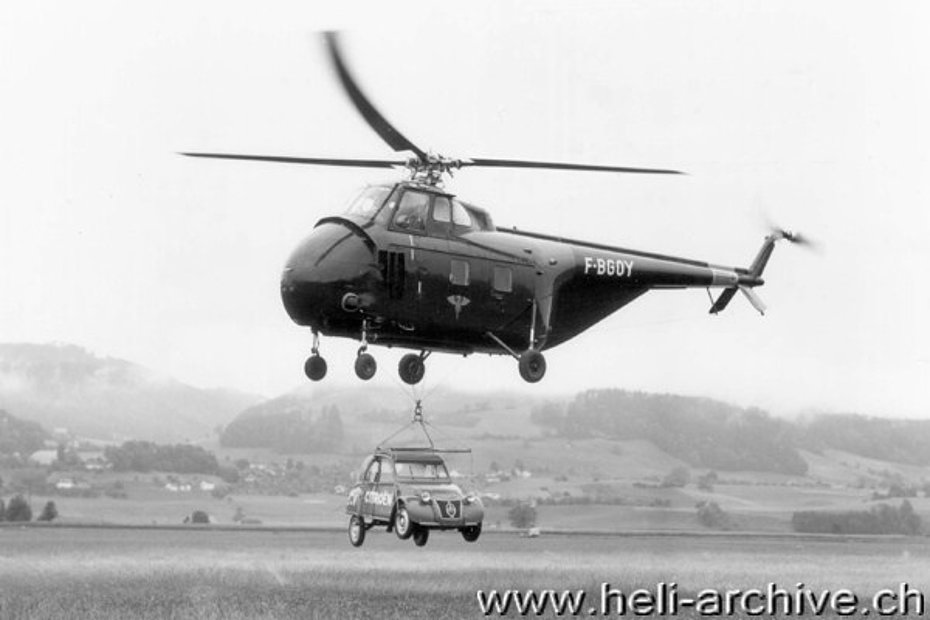
The Sikorsky S-55 in Switzerland
As said before, the Sikorsky was also manufactured under licence by the French SNCASE. The latter curiously nicknamed the helicopter "éléphant joyeux" (joyful elephant).
With the intent to boost the sale of the new helicopter, in June 1953 the manufacturer organized a promotional tour which involved the cities of Paris, Berne and Rome.
The newly founded Schweizerische Helikopter AG (Heliswiss AG and nowadays Swiss Helicopter AG) asked SNCASE to show the S-55.
On the 11th and 12th of June the S-55 registered F-BGOY (s/n 55-383) piloted by Gérard Henry and Jean Boulet did several flights on the airport of Belp/BE.
During the demonstration the helicopter was used to transport passengers and goods.
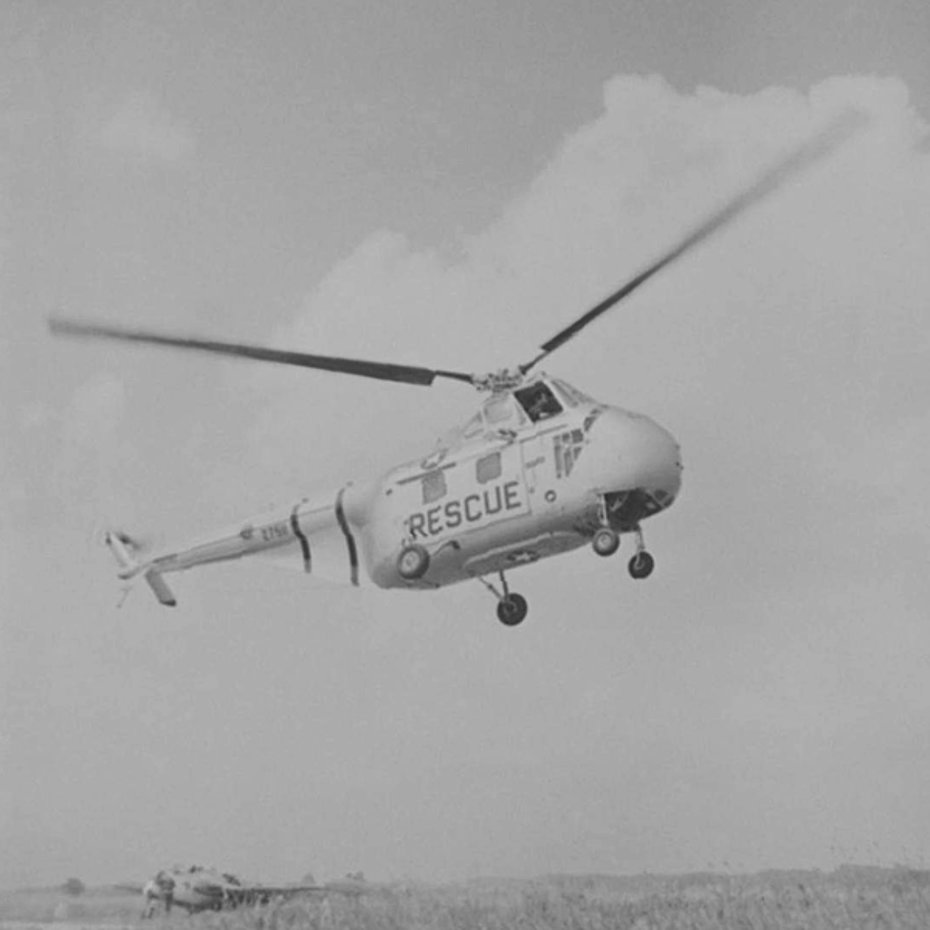
The helicopter was equipped with an hydraulic hoist which was used to simulate rescue operations.
The S-55 was impressive not only for its performance but also for its price, which was absolutely out of reach for the newly founded helicopter company.
The interesting demonstration in Belp was filmed by a troupe of the Swiss newsreel which produced the footage nr. 579.
Due to the adverse meteorological conditions the program was changed and consequently the helicopter was not tested in the mountains as instead originally planned.
For these reasons the following year another S-55 was invited to Switzerland with the aim of a new series of test.
The evaluation program was directed by Hansueli Weber, a military pilot who was previously employed by the Federal Office of Civil Aviation in Berne.
Weber was also the holder of the second helicopter pilot licence issued in Switzerland.
The aircraft tested was the Sikorsky H-19B (s/n 52-7511A) based in Monaco (Germany) with the US Army.
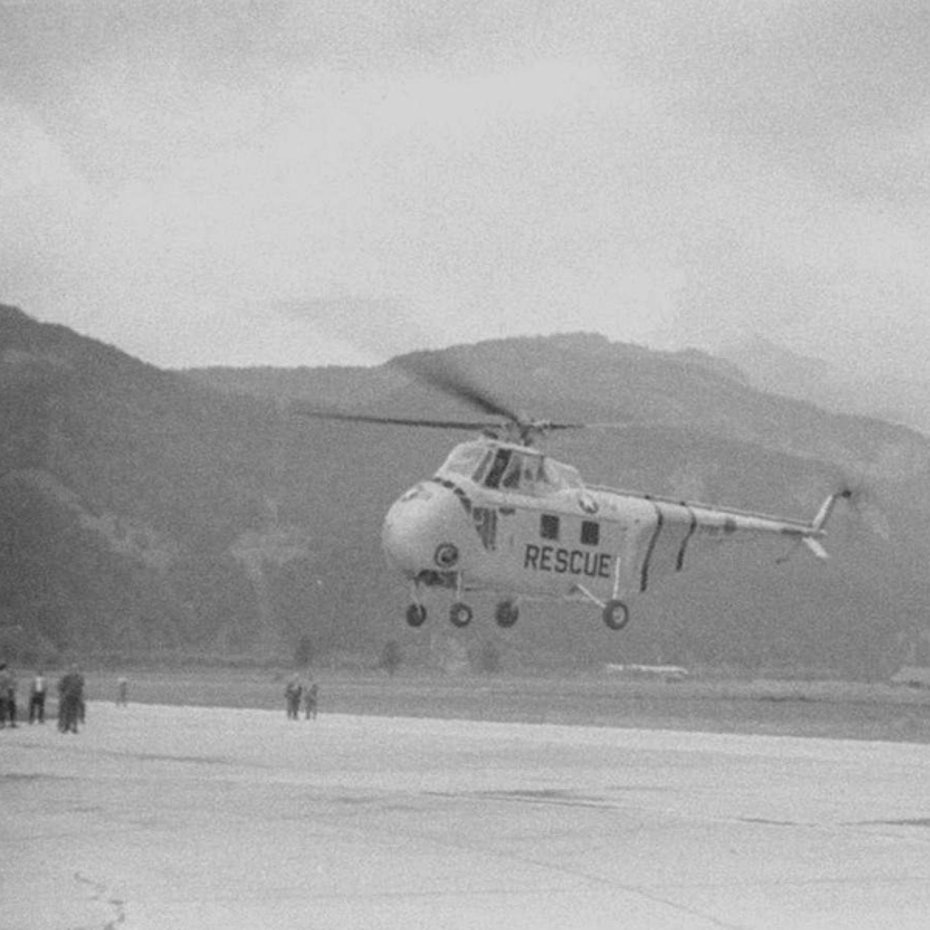
It arrived in Switzerland on the 22nd of June piloted by a crew made up by the pilots Mc Kee and Wykoff and their colleagues Santos and Farrel.
In the following days the H-19B helicopter underwent a series of tests on the military airports of Emmen/LU and Meiringen/BE.
On the 25th of June it was tested on the Susten Pass at an elevation of 2'224 m/sm.
However the American pilots, who had a limited flight experience in the mountains, did not complete the test program or reduced the payload considerably for safety reasons.
Between the 22nd and the 30th of June the H-19B flew altogether 8 hours. It then left Switzerland and returned in Germany.
The Sikorsky S-55 reappeared in Switzerland many years later but this time powered by a turbine, but this is another story which will be narrated separately.
The H-19B in flight – The opinion of an expert
Weber was charged by the Swiss military department to write a detailed test report about the H-19B.
Compared to the F-BGOY the H-19B was powered by a more powerful 597/800 kW/shp Wright Cyclone R-1300-3.
Weber’s judgement was all things considered positive.
He wrote for example that the vibrations level in flight was low, except during the flare phase.
However he was a bit preoccupied because occasionally the pilot’s cabin was pervaded by the exhaust gases. He also wrote that the quality of the radio communication was poor and that the pilot's visual was quite limited during the landing maneuver. He found that the quadricycle landing gear and the big nose were not practical especially for mountain operation.
He also said that it was a shame that the tail rotor was not fitted with a hydraulic system.
Do you know that…
Between the 15th and the 31st of July 1952 two H-19B nicknamed "Hopalong" and "Whirloway" were the first helicopter to complete the Atlantic cross? The H-19B Hopalong was piloted by captains Vincent H. Mc Govern and Harry C. Jeffers, while the Whirloway was piloted by the 1st Lt. Harold W. Moore and the captain George D. Hambrick.
The two helicopters took off from the military base of Westover (Massachussets) and landed in Prestwick (Scotland) after a 6'400 km trip. The distance was covered in 42h25’ of flight.
The first civil S-55 (N412A) was sold to Los Angeles Airways and was transferred in flight from Bridgeport to Los Angeles. On the 9th of April the helicopter was used to inaugurate NYA's first passengers service.
Unfortunately one hour after the ceremony, while returning to the Los Angeles airport with five on board, the helicopter had a tail rotor failure and crashed. In the accident all the occupants were seriously injured.
Consequently for a short period the other S-55 ready to be delivered were forced on the ground until the cause of the failure was found and the technical problem solved.
Nowadays very few S-55 are still in flying condition. The Brewster (Washington State) based Golden Wings Aviation company uses some S-55 (piston and turbine powered) - among other duties such as agricultural spraying, forestry work, charter service and aircraft restoration - to dry cherries.
If you want more information have a look at this article: http://www.capitalpress.com/content/djw-cherrychopper-w-art-060311
Absolutely don't miss this video:
www.youtube.com/watch
Strange but true
Strangely it seems that nobody really knows exactly when the S-55 made its first flight. The literature indicates different dates: 4th, 7th, 10th or even the 21st of November 1949. In the article I wrote the 7th, because I found a postcard printed by the Sikorsky company celebrating this date.
HAB 10/2011

